A Study on the Hydrophobicity and Icephobicity of Modified Cement-Based Composite Coatings for Anti-/De-Icing of Guardrail Concrete
Abstract
1. Introduction
2. Experiments
2.1. Raw Materials
2.2. Preparation of Cement-Based Composite Coatings
2.3. Wettability Test
2.4. Mechanical Properties
2.5. Chemical Stability
2.6. Icephobicity Evaluation
2.7. Characterization of Coatings
3. Results and Discussion
3.1. Chemical Composition and Coating Morphology
3.2. Wettability
3.3. Mechanical Properties of Coatings
3.4. Chemical Stability of Coatings
3.5. Icephobicity of Coated Concrete
4. Conclusions
- (1)
- The hydrophobic agent synthesized using nano-silica, TEOS and PFDTS incorporated F-containing functional groups into the cement-based composite coating and increased the surface roughness. This resulted in a low surface energy of the coating. Compared to the coatings prepared with the commercial hydrophobic agent, those prepared with the synthetic hydrophobic agent had a rougher morphology.
- (2)
- The coatings prepared with the synthetic hydrophobic agent had better hydrophobicity compared to those prepared with the commercial hydrophobic agent. The former treated by impregnation even presented super-hydrophobicity with a contact angle exceeding 150°. This is consistent with the surface roughness of the coating morphology.
- (3)
- The coatings prepared with the synthetic hydrophobic agent maintained a higher contact angle after sandpaper abrasion and solution immersion. The loss rate of contact angle after abrasion was higher for the coatings treated by impregnation, but that after solution immersion was lower. Coatings treated by impregnation still presented better mechanical properties and chemical stability.
- (4)
- The coatings significantly delayed the time of icing for the concrete samples, reduced the icing mass and ice adhesion strength. This illustrated that the coatings effectively enhanced the icephobicity of concrete. The coatings prepared with the synthetic hydrophobic agent by impregnation presented a better icephobicity. This study guided the utilization of modified cement-based composite coating for anti-/de-icing of guardrail concrete.
Author Contributions
Funding
Data Availability Statement
Conflicts of Interest
References
- Zhou, P.; Gu, K.; Jiang, Z. Preparation and Properties of Non-Autoclaved High-Strength Pile Concrete with Anhydrite and Ground Granulated Blast-Furnace Slag. Case Stud. Constr. Mater. 2024, 21, e03597. [Google Scholar] [CrossRef]
- Zheng, Q.; Yang, E.H.; Jiang, Z. Autolytic Microsphere Capsules Using in Cement Composites: A Self-Healing Enhancement via Hydration Control and Secondary Cracking Mode Alteration. Constr. Build. Mater. 2025, 463, 140128. [Google Scholar] [CrossRef]
- Li, W.; Dong, B.; Yang, Z.; Xu, J.; Chen, Q.; Li, H.; Xing, F.; Jiang, Z. Recent Advances in Intrinsic Self-Healing Cementitious Materials. Adv. Mater. 2018, 30, 1705679. [Google Scholar] [CrossRef] [PubMed]
- He, B.; Zhu, X.; Zhang, H.; Wang, A.; Sun, D.; Banthia, N.; Jiang, Z. Nano-Engineering Steel Fiber for UHPC: Implication for Varying Cryogenic and Elevated Exposure. Cem. Concr. Compos. 2025, 156, 105851. [Google Scholar] [CrossRef]
- Li, J.; Li, S.; Aminul Haque, M.; Chen, B. Water-Resistance Performance Analysis of Portland Composite Concrete Containing Waterproofing Liquid Membrane. J. Build. Eng. 2023, 76, 106889. [Google Scholar] [CrossRef]
- Li, C.; Ren, Q.; Qian, X.; Zhao, H.; Jiang, Z. Synergistic Load-Bearing Performance of Inflated Membrane-Concrete Composite Structure for Pavement. Constr. Build. Mater. 2025, 462, 139978. [Google Scholar] [CrossRef]
- Zhang, J.; Sun, M.; Hou, D.; Li, Z. External Sulfate Attack to Reinforced Concrete under Drying-Wetting Cycles and Loading Condition: Numerical Simulation and Experimental Validation by Ultrasonic Array Method. Constr. Build. Mater. 2017, 139, 365–373. [Google Scholar] [CrossRef]
- Cao, Y.; Gehlen, C.; Angst, U.; Wang, L.; Wang, Z.; Yao, Y. Critical Chloride Content in Reinforced Concrete—An Updated Review Considering Chinese Experience. Cem. Concr. Res. 2019, 117, 58–68. [Google Scholar] [CrossRef]
- Li, C.; Wu, M.; Chen, Q.; Jiang, Z. Chemical and Mineralogical Alterations of Concrete Subjected to Chemical Attacks in Complex Underground Tunnel Environments during 20–36 Years. Cem. Concr. Compos. 2018, 86, 139–159. [Google Scholar] [CrossRef]
- Yumrutaş, H.İ.; Othman Ali, Z. Experimental Performance Evaluation of an Innovative Hybrid Barrier System Filled with Waste Materials. Constr. Build. Mater. 2022, 316, 125231. [Google Scholar] [CrossRef]
- Atahan, A.O.; Sevim, U.K. Testing and Comparison of Concrete Barriers Containing Shredded Waste Tire Chips. Mater. Lett. 2008, 62, 3754–3757. [Google Scholar] [CrossRef]
- Su, L.; Ma, Z.; Niu, D.; Huang, D.; Sun, Z.; Zhang, Y.; Luo, Y. Corrosion Characteristics of Basalt-Polypropylene Hybrid Fiber Concrete under the Compound Salt and Drying-Wetting Cycles. Constr. Build. Mater. 2024, 419, 135529. [Google Scholar] [CrossRef]
- Zhang, H.; Chen, W.; He, B.; Zhu, X.; Jiang, Z. Compressive Behaviour and Microstructure of Geopolymer Mortar Subjected to Cryogenic Freeze-Thaw Cycle: Effects of Cycles and Polypropylene Fiber. Cem. Concr. Compos. 2024, 149, 105505. [Google Scholar] [CrossRef]
- Zhang, H.; He, B.; Cheng, Y.; Tang, Y.; Ren, Q.; Zhu, X.; Jiang, Z. Strengthening and Embrittlement Effect of Cryogenic Temperature on Fiber Reinforced Geopolymer Composite. Cem. Concr. Compos. 2024, 153, 105727. [Google Scholar] [CrossRef]
- Huang, J.; Niu, D.; Lv, Y.; Li, Z. Deterioration Mechanism and Pore Structure Characteristics of Concrete under the Coupling Effect of SO2 and CO2. J. Build. Eng. 2025, 100, 111760. [Google Scholar] [CrossRef]
- Huang, D.; Wang, X.; Li, X.; Su, L.; Tian, J. Advanced Nuclear Magnetic Resonance Technology Analysis of Hybrid Fiber Reinforced Concrete for Optimized Pore Structure and Strength. Constr. Build. Mater. 2025, 467, 140383. [Google Scholar] [CrossRef]
- Ren, Z.; Dong, W.; Dong, X. Analysis of Fractal and Erosion Characteristics of Aeolian Sand Concrete Pore Structure under Capillary Absorption. J. Build. Eng. 2025, 104, 112258. [Google Scholar] [CrossRef]
- Martys, N.S.; Ferraris, C.E. Capillary Transport in Mortars and Concrete. Cem. Concr. Res. 1997, 27, 747–760. [Google Scholar] [CrossRef]
- Zhang, L.; Huang, M.; Yang, F.; Zhang, W. A Novel Hydrophilic Modification Method of EPS Particles: Conception Design and Performances in Concrete. Cem. Concr. Compos. 2023, 142, 105199. [Google Scholar] [CrossRef]
- Al-Rashed, R.; Al-Jabari, M. Concrete Protection by Combined Hygroscopic and Hydrophilic Crystallization Waterproofing Applied to Fresh Concrete. Case Stud. Constr. Mater. 2021, 15, e00635. [Google Scholar] [CrossRef]
- Li, F.; Luo, D.; Niu, D. Durability Evaluation of Concrete Structure under Freeze-Thaw Environment Based on Pore Evolution Derived from Deep Learning. Constr. Build. Mater. 2025, 467, 140422. [Google Scholar] [CrossRef]
- Shen, Y.; Lv, Y.; Yang, H.; Ma, W.; Zhang, L.; Pan, J. Effect of Different Ice Contents on Heat Transfer and Mechanical Properties of Concrete. Cold Reg. Sci. Technol. 2022, 199, 103570. [Google Scholar] [CrossRef]
- Jin, L.; Lu, B.; Yu, W.; Xie, C.; Du, X. Direct Tensile Failures of Concrete with Various Moisture Contents and Sizes at Low Temperatures via Mesoscale Simulations with Ice Explicit Modelling. Constr. Build. Mater. 2024, 449, 138300. [Google Scholar] [CrossRef]
- Li, G.; Boulfiza, M.; Evitts, R. On the Subtilities of Rebar Corrosion Behaviour in Cracked Concrete. Cem. Concr. Compos. 2025, 160, 106038. [Google Scholar] [CrossRef]
- Tong, L.Y.; Liu, Q.F.; Xiong, Q.; Meng, Z.; Amiri, O.; Zhang, M. Modeling the Chloride Transport in Concrete from Microstructure Generation to Chloride Diffusivity Prediction. Comput.-Aided Civ. Infrastruct. Eng. 2024, 24, 1129–1149. [Google Scholar] [CrossRef]
- Du, X.; Li, G.; Cao, A.; Wang, A.; Zhou, Y. Study of Transport and Binding Behavior of Chloride Ions in Concrete under Single-Sided Salt-Freezing Cycle. Constr. Build. Mater. 2025, 471, 140749. [Google Scholar] [CrossRef]
- Yuan, M.; Zhang, L.; Wan, J.; Li, Y.; Xu, W.; Qi, Y.; Xie, Z.; Xu, W. Analysis of Factors Affecting Structural Durability Based on Reinforced Concrete Corrosion-Induced Cracking. Structures 2025, 75, 108677. [Google Scholar] [CrossRef]
- Das, C.S.; Zheng, H.; Dai, J.G. A Review of Chloride-Induced Steel Corrosion in Coastal Reinforced Concrete Structures: Influence of Micro-Climate. Ocean. Eng. 2025, 325, 120794. [Google Scholar] [CrossRef]
- Yamamoto, M.; Nakarai, K.; Yoshizumi, Y.; Torrent, R. Relationship between Chloride Ingress and Concrete Cover Quality of Inland Structures Exposed to Deicing Salts. Case Stud. Constr. Mater. 2024, 20, e03075. [Google Scholar] [CrossRef]
- Gu, W.; Liu, R.; Zhang, Y.; Yu, X.; Feng, P.; Ran, Q.; Zhang, Y.; Zhang, Y. Robust Water-Borne Multi-Layered Superhydrophobic Coating on Concrete with Ultra-Low Permeability. Constr. Build. Mater. 2024, 411, 134573. [Google Scholar] [CrossRef]
- Lai, X.; Wang, Y.; Wang, Y.; Sun, X. TA/SiO2 Hydrophobic Coating and Its Effect on Corrosion Resistance of Concrete. J. Build. Mater. 2024, 27, 30–36. [Google Scholar]
- Wang, X.F.; Pei, C.; Wei, L.; Zhu, J.H. Enhancing Cement-Based Inorganic Coating Performance through the Integration of Graphene-Titanium Dioxide Composite Nanofibers. Case Stud. Constr. Mater. 2025, 22, e04539. [Google Scholar] [CrossRef]
- Xu, L.; Wang, Y.; Sun, X.; Chen, X.; Wang, Y. Study of a New Hydrophobic Coating with CMC as Binder and Its Effect on Concrete Erosion Resistance. J. Build. Eng. 2025, 104, 112212. [Google Scholar] [CrossRef]
- Yang, J.; Li, J.; Xu, P.; Chen, B. Robust and Transparent Superoleophobic Coatings from One-Step Spraying of SiO2@fluoroPOS. J. Solgel Sci. Technol. 2020, 93, 79–90. [Google Scholar] [CrossRef]
- Ajir, K.; Toufigh, V.; Ghaemian, M. Protecting Ordinary Cement Concrete against Acidic and Alkaline Attacks Utilizing Epoxy Resin Coating. Constr. Build. Mater. 2025, 472, 141003. [Google Scholar] [CrossRef]
- Deng, Z.; Wen, X.; Zhou, M. Research Progress of Silane Impregnation and Its Effectiveness in Coastal Concrete Structures: A Review. J. Build. Eng. 2024, 91, 109550. [Google Scholar] [CrossRef]
- Li, M.; Wu, C.; Jin, Z.; Hou, D.; Chen, J. Research progress on silane protective coatings of cementitious materials in coastal environment. J. Build. Mater. 2024, 27, 332–342. [Google Scholar] [CrossRef]
- Zhao, Y.; Wang, J.; Hu, M.; Niu, Y.; Liang, N. Fabrication of Cement-Based Superhydrophobic Coatings with Enhanced Self-Cleaning Property, Chemical Stability, and UV-Radiation Resistance. J. Build. Eng. 2024, 91, 109606. [Google Scholar] [CrossRef]
- Chen, H.; Zhang, H.; Ren, Q.; Zhang, B.; Zhu, X.; He, B.; Yang, Z.D.; Jiang, Z. Characterization and Stability of Innovative Modified Nanosilica-Resin Composite Coating: Subjected to Mechanical, Chemical, and Cryogenic Attack. Prog. Org. Coat. 2024, 197, 108780. [Google Scholar] [CrossRef]
- Li, Y.; Sha, A.; Wang, Z.; Liu, Z. Laboratory Measurement of the Adhesion Strength between Asphalt Concrete and Ice Layer. Constr. Build. Mater. 2024, 416, 135102. [Google Scholar] [CrossRef]
- Lin, C.; Suo, G.; Mu, R.; Li, J.; Habib, L.; Hou, X.; Ding, S.; Zhu, J. PFDTS/SiO2 Dual-Modified Hierarchical TiO2 Nanostructures for Sandstone Cultural Relics Preservation Coatings with Enhanced Weathering Resistance. Prog. Org. Coat. 2025, 200, 109040. [Google Scholar] [CrossRef]
- Zheng, Y.; Wang, K.; Sun, L.; Shi, H.; Zhang, X. Preparation of PFDTS-Kaolin/PU Superamphiphobic Coatings with Antibacterial, Antifouling and Improved Durability Property. Prog. Org. Coat. 2022, 173, 107145. [Google Scholar] [CrossRef]
- Wu, Y.; Dong, L.; Shu, X.; Yang, Y.; She, W.; Ran, Q. A Review on Recent Advances in the Fabrication and Evaluation of Superhydrophobic Concrete. Compos. Part B Eng. 2022, 237, 109867. [Google Scholar] [CrossRef]
- Sheen, Y.C.; Huang, Y.C.; Liao, C.S.; Chou, H.Y.; Chang, F.C. New Approach to Fabricate an Extremely Super-Amphiphobic Surface Based on Fluorinated Silica Nanoparticles. J. Polym. Sci. B Polym. Phys. 2008, 46, 1984–1990. [Google Scholar] [CrossRef]
- Matziaris, K.; Stefanidou, M.; Karagiannis, G. Impregnation and Superhydrophobicity of Coated Porous Low-Fired Clay Building Materials. Prog. Org. Coat. 2011, 72, 181–192. [Google Scholar] [CrossRef]
- Yang, F.; Zhou, W.; Li, F.; Yuan, L.; Diao, Y.; Liu, Y.; Pu, Y.; Zhang, Y.; Zhao, Y.; Jiang, O.; et al. Sprayable Coating Based on Fluorinated Silica Nanocomposites with Superhydrophobic and Antibacterial Properties for Advanced Concrete. Prog. Nat. Sci. Mater. Int. 2022, 32, 472–481. [Google Scholar] [CrossRef]
- Dai, Z.; Guo, H.; Wang, Y.; Wang, M.; Zhang, Y.; Qian, K. Mechanically Strength with Water Repellency: Recently Advances in Superhydrophobic Concrete. J. Clean. Prod. 2025, 491, 144839. [Google Scholar] [CrossRef]
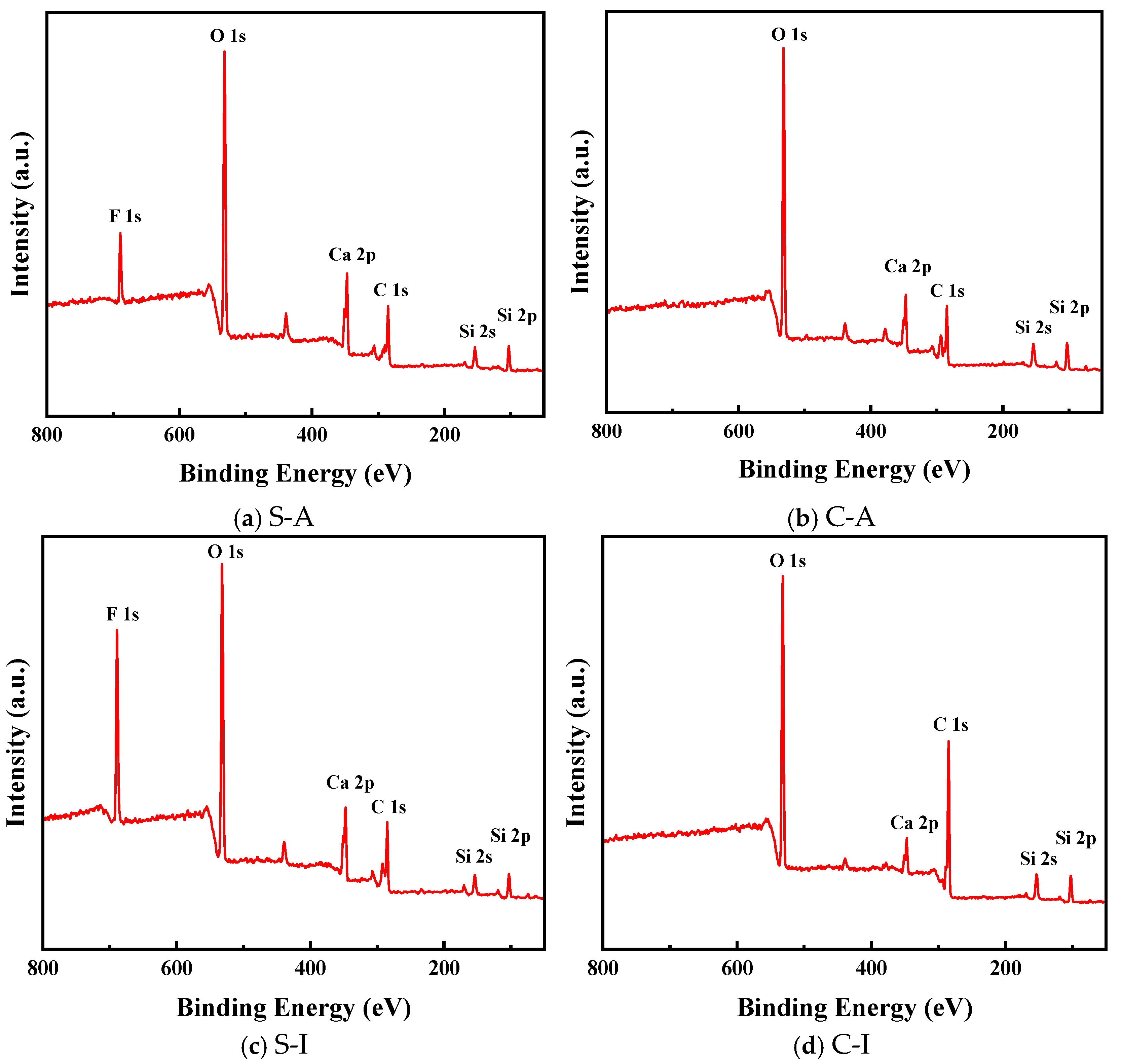

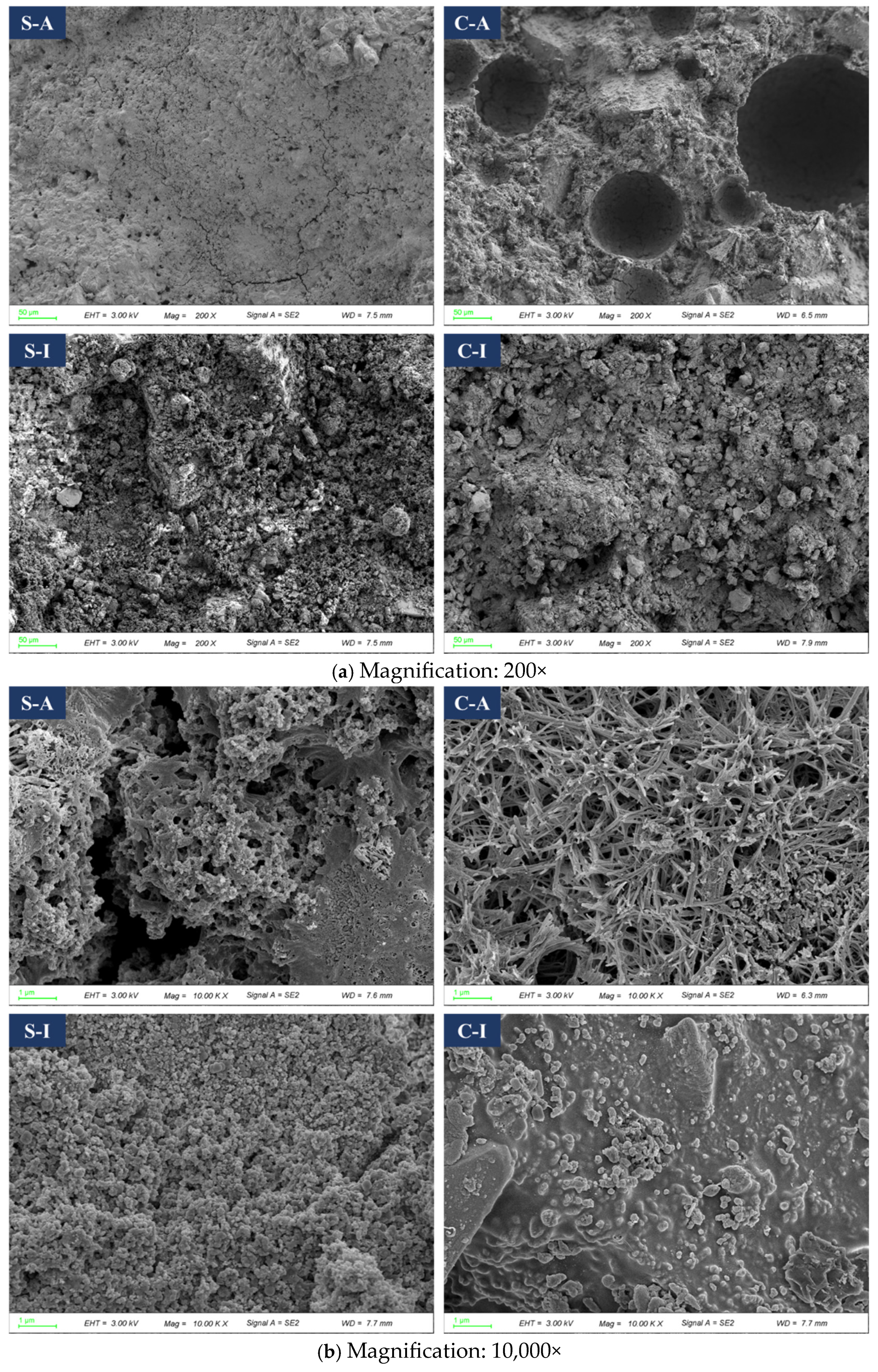
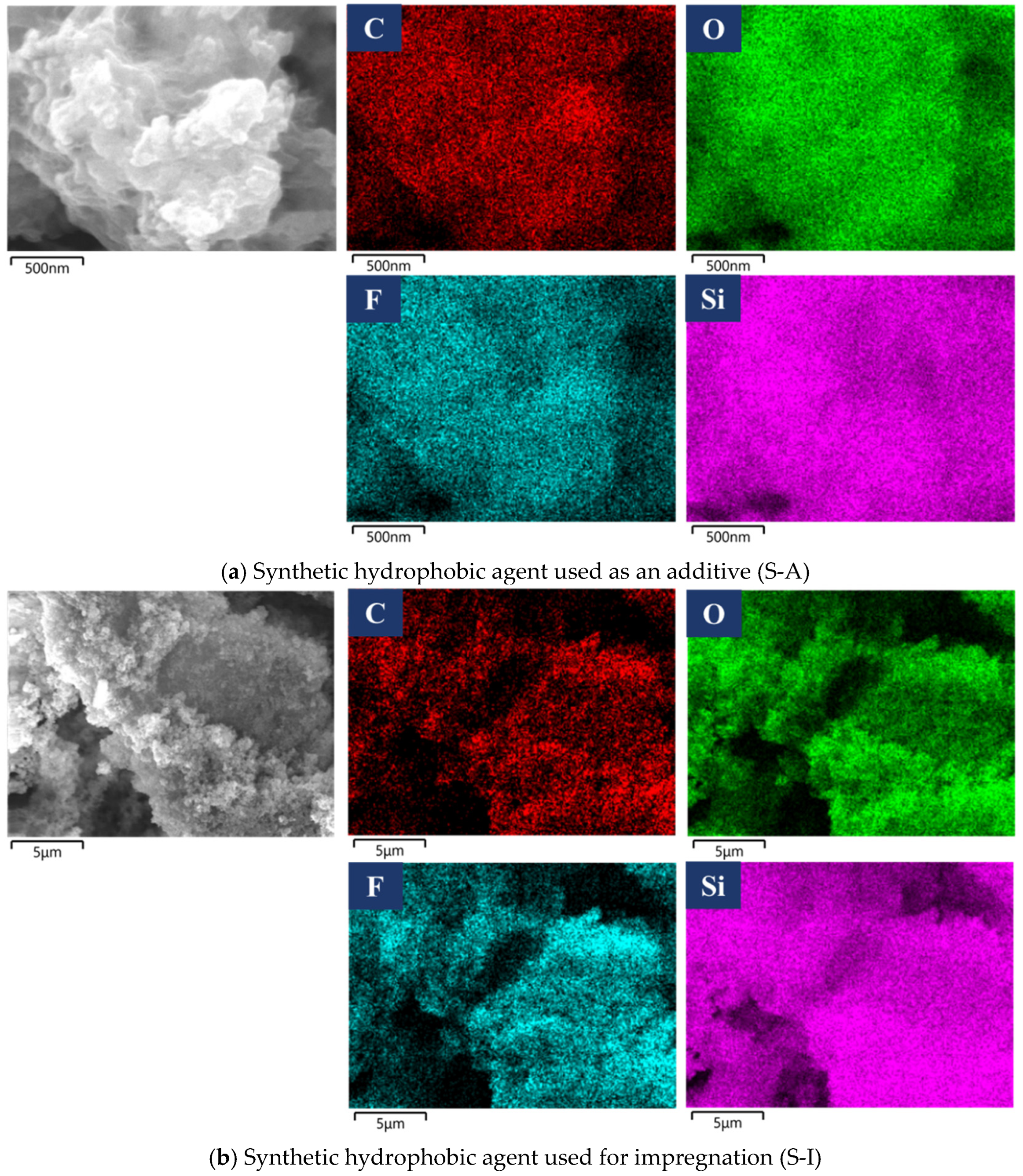
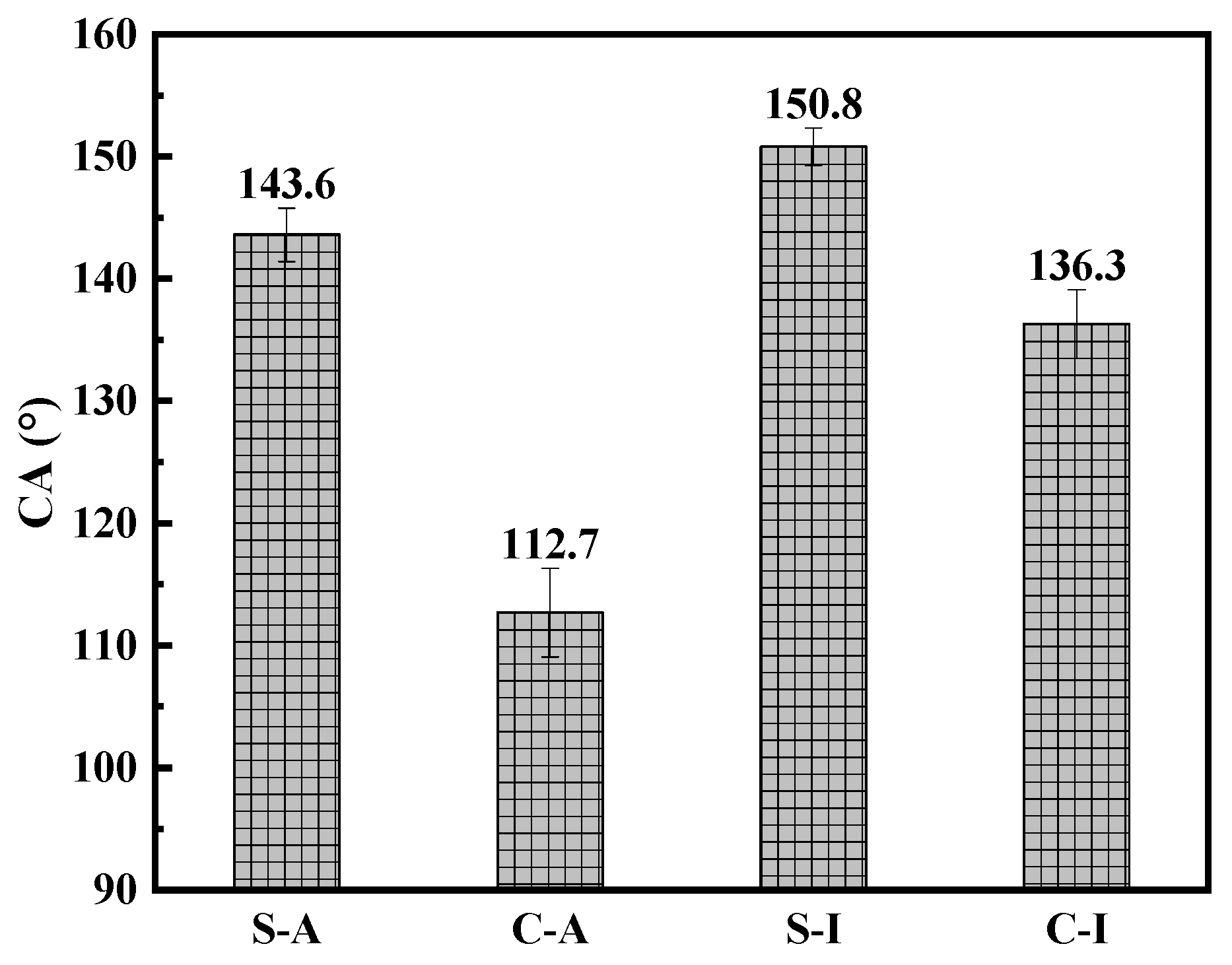
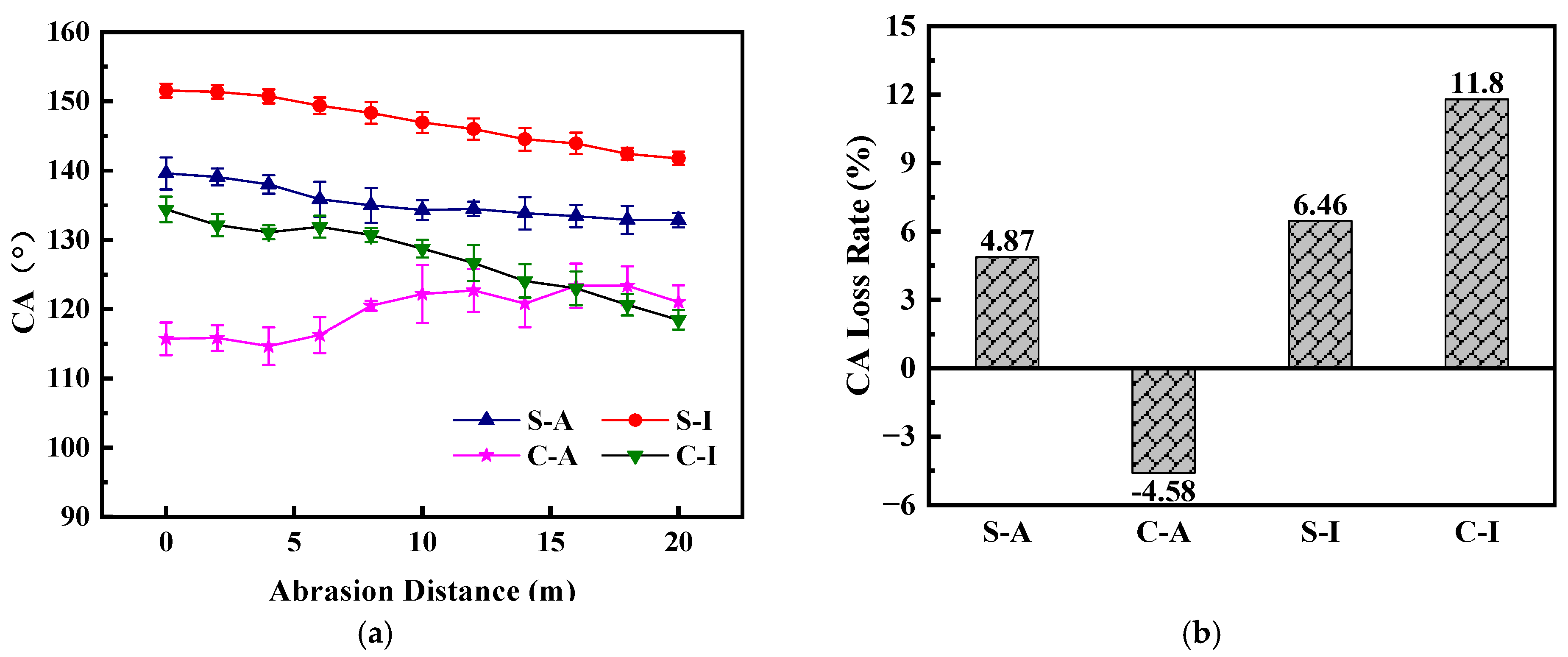
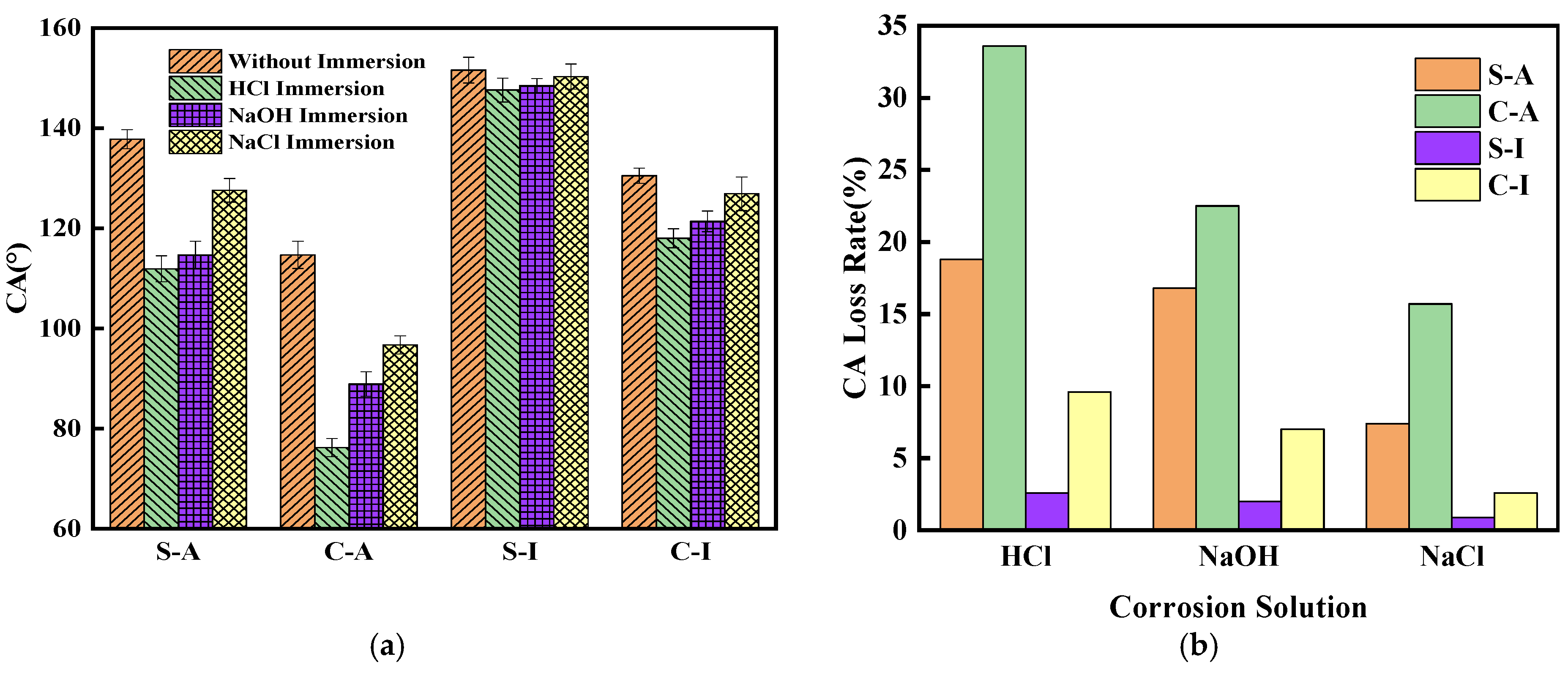

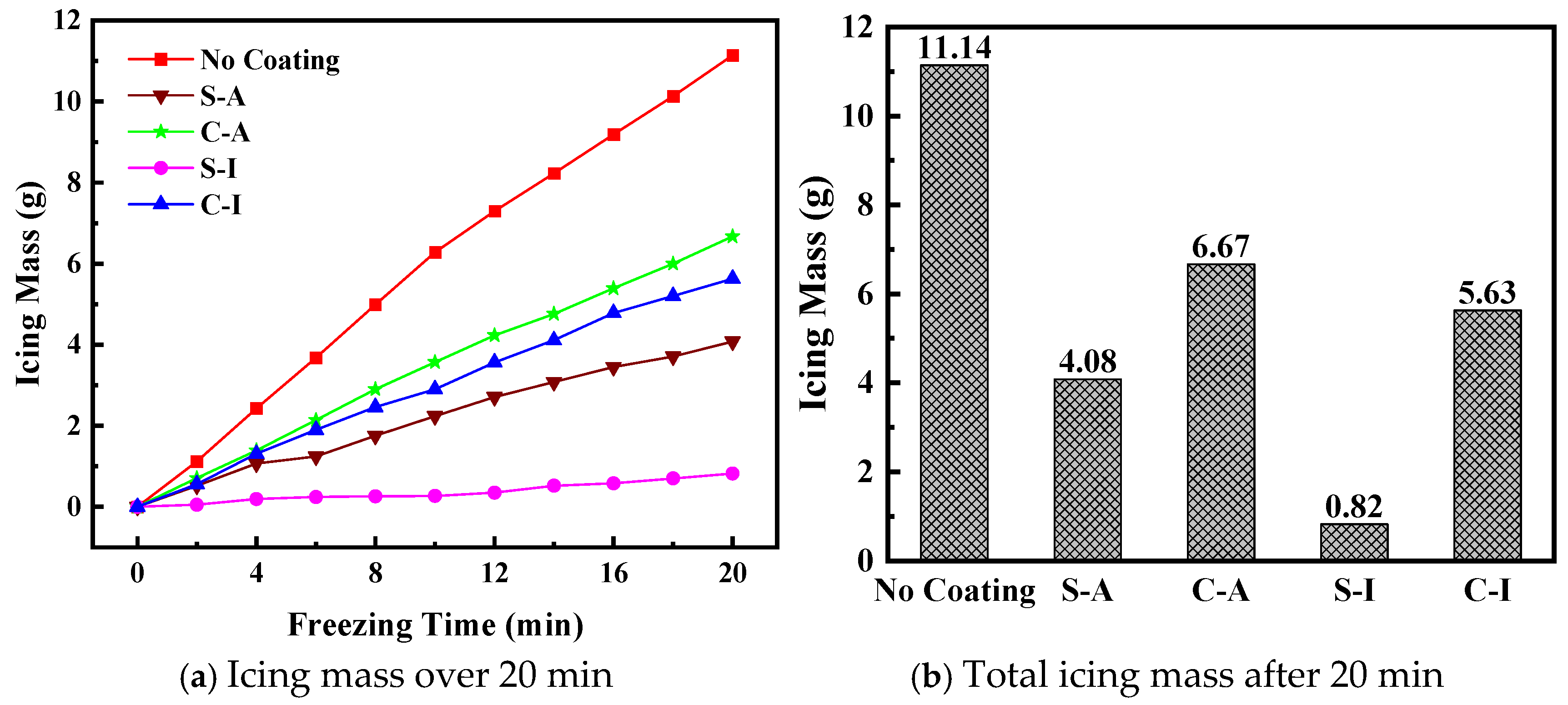
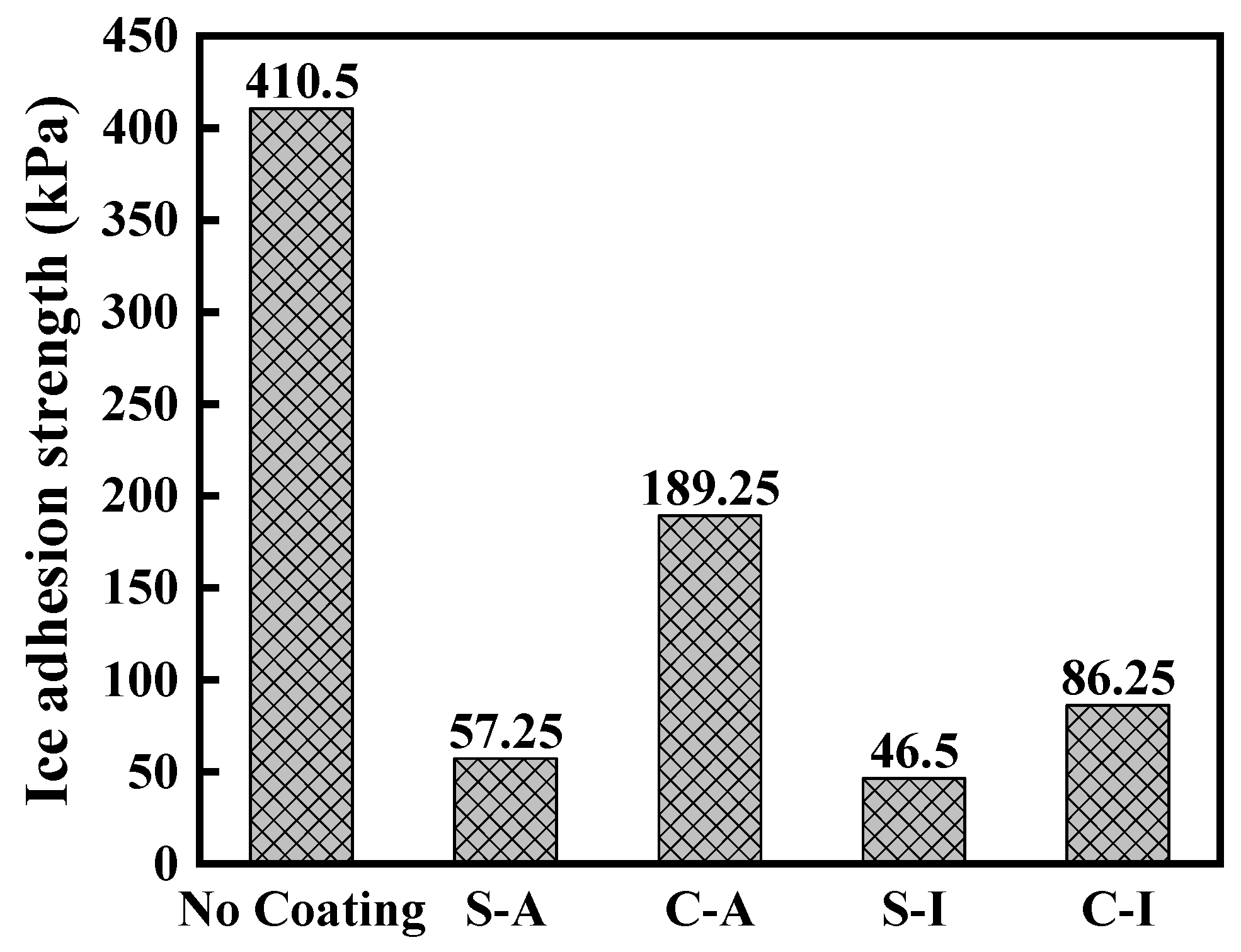
| Group | Cement | Sand | Water | Hydrophobic Agent | ||
|---|---|---|---|---|---|---|
| Type | Usage | Dosage | ||||
| S-A | 10 g | 20 g | 5 g | Synthetic | Additive | 3 g |
| C-A | Commercial | Additive | ||||
| S-I | Synthetic | Impregnation | ||||
| C-I | Commercial | Impregnation | ||||
Disclaimer/Publisher’s Note: The statements, opinions and data contained in all publications are solely those of the individual author(s) and contributor(s) and not of MDPI and/or the editor(s). MDPI and/or the editor(s) disclaim responsibility for any injury to people or property resulting from any ideas, methods, instructions or products referred to in the content. |
© 2025 by the authors. Licensee MDPI, Basel, Switzerland. This article is an open access article distributed under the terms and conditions of the Creative Commons Attribution (CC BY) license (https://creativecommons.org/licenses/by/4.0/).
Share and Cite
Gao, J.; Zhou, P.; Shi, X.; Gu, K.; Chen, H.; Yang, Q.; Jiang, Z. A Study on the Hydrophobicity and Icephobicity of Modified Cement-Based Composite Coatings for Anti-/De-Icing of Guardrail Concrete. Buildings 2025, 15, 2263. https://doi.org/10.3390/buildings15132263
Gao J, Zhou P, Shi X, Gu K, Chen H, Yang Q, Jiang Z. A Study on the Hydrophobicity and Icephobicity of Modified Cement-Based Composite Coatings for Anti-/De-Icing of Guardrail Concrete. Buildings. 2025; 15(13):2263. https://doi.org/10.3390/buildings15132263
Chicago/Turabian StyleGao, Jianping, Pan Zhou, Xianlong Shi, Kang Gu, Hongji Chen, Qian Yang, and Zhengwu Jiang. 2025. "A Study on the Hydrophobicity and Icephobicity of Modified Cement-Based Composite Coatings for Anti-/De-Icing of Guardrail Concrete" Buildings 15, no. 13: 2263. https://doi.org/10.3390/buildings15132263
APA StyleGao, J., Zhou, P., Shi, X., Gu, K., Chen, H., Yang, Q., & Jiang, Z. (2025). A Study on the Hydrophobicity and Icephobicity of Modified Cement-Based Composite Coatings for Anti-/De-Icing of Guardrail Concrete. Buildings, 15(13), 2263. https://doi.org/10.3390/buildings15132263








